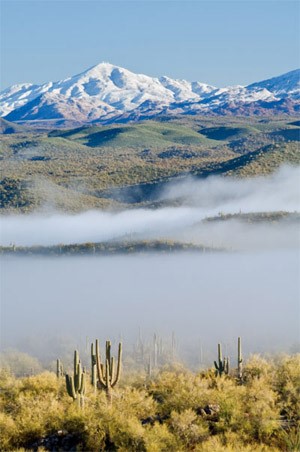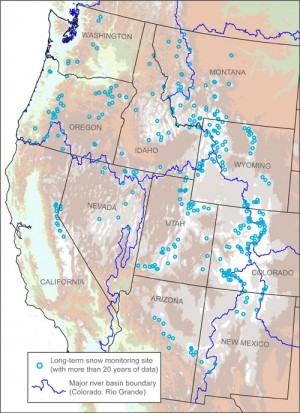Mountain Snowpack in the West and Southwest
Mountain snow plays a critical role in the hydrological cycle for most western states, stockpiling water during the winter and releasing it to the streams in the spring and early summer, which helps meet increasing demands for water.

A thick blanket of fog hovers over the Salt River in central Arizona following a winter storm that delivered a fresh coating of snow to the surrounding mountains.
Credit: ©Ron Adcock, istockphoto.com
In the West, as much as 70 percent of the region’s precipitation falls during winter. Arizona and New Mexico are critically dependant on this winter precipitation. The region’s two main water lifelines, the Colorado River and the Rio Grande, tap the winter snows in the Rocky Mountains for approximately 70 percent of their annual water flow.
Many water and land managers as well as citizens, farmers, and ranchers are interested in three critical questions: How has the snowpack been changing, what are the likely future changes, and what are the effects of these changes? To address these concerns and to better understand changes in snowpack from natural climate variability and human-spurred change, research has focused on clarifying:
- Observed snowpack-related trends
- Changes to snowpack-related trends
- Impacts of observed and predicted snowpack changes
Observed snowpack-related trends
Based on long-term monitoring of snow (Figure 2) the general picture for the 11 states in the western U.S. is clear. In comparison to time periods before 1950, winter snowpack is melting earlier in the year, rain is replacing some snow storms, and the April snowpack now contains less water. These changes are affecting streamflows (see table 1 for recent research on snowpack and streamflow). According to observations, dates of the first major spring snowmelt as well as the peak in streamflow are occurring earlier in the year by as much as four weeks1. Although these trends are influenced by natural climate variability, such as El Niño-Southern Oscillation (ENSO) and the Pacific Decadal Oscillation, the increasing temperature attributed to global warming has played a significant, if not dominant, role.
In the Southwest, however, the picture is not as sharp because most scientific research has focused on the whole western region and not specifically on the mountains that contribute water to the Southwest. In the headwaters of the Colorado and Rio Grande, increases as well as decreases in snowpack have been observed in spite of the overarching rise in temperature. This variability occurs for several reasons. First, the Rocky Mountains crest at higher elevations, which typically make them colder.
Table 1. Recent Publications on Snowpack and Streamflows in the West and Southwest.
VIC = Variable Infiltration Capacity; PDO = Pacific Decadel Oscillation; ENSO = El Niño Southern Oscillation
| Publication Title | Data Type Used | ||
| Snow | Streamflow | Other | |
|
Effects of Temperature and Precipitation Variability on Snowpack Trends in the Western United States |
Snow water equivalent on March 1, April 1, and May 1 via VIC model |
PDO, ENSO influence |
|
|
Trends in Snowfall versus Rainfall in the Western United States |
Daily snow water equivalent |
PDO, ENSO influence |
|
|
Declining Snowpack in Western North America |
Snow water equivalent on April 1 |
PDO, ENSO influence |
|
|
Seasonal Shifts in Hydroclimatology over the Western United States |
Snow water equivalent in March, April, May |
Runoff timing, averages |
PDO, ENSO influence |
Recent warming, therefore, has not been sufficient to raise winter temperatures above the melting point on a consistent basis. Second, some of the analyses of snowpack and streamflow suffer from an observational record that begins in the major regional drought of the 1950s. An outcome of analyzing precipitation trends from data that begin in a period of drought is that the precipitation can appear to increase over the record when in reality no increase is occurring. Third, some areas may have experienced an increase in snowfall, which masked any reductions in snowpack due to warmer temperatures.
Even though variability exists in snowpack amounts, streamflows in the Colorado River, Rio Grande, and several other southwestern rivers appear to be peaking earlier in the year1. Since streamflows integrate upstream changes in snowpack, earlier streamflows suggest that the spring temperatures are warmer than in the past.
Snow in the mountains of Arizona and New Mexico also contributes to the flows of major rivers such as the Colorado, Rio Grande, Salt, and Gila. In Arizona, snowpack is monitored at numerous locations (Figure 3). At several of these sites, recent unpublished research suggests that the water content in the spring snowpack has decreased over the 1975 to 2004 period.
Predicted changes to snowpack-related trends

Figure 1. Snow monitoring sites in the Western U.S. with at least 20 years of data.
| Enlarge This Figure |
Credit: Joe Abraham, Institute of the Environment, The University of Arizona
Climate models suggest that the West will likely warm between 3.5 and 9 degrees F (2 to 5 degrees C) over the next century. The future estimates of precipitation, however, are less certain. Temperature changes will likely continue to drive losses in the snowpack in many western regions and may even accelerate the melting, with faster losses in the mountains of the milder climates like the Pacific Northwest and slower losses in the colder mountains of the northern Rockies.
Christensen and Lettermaier (2006) derived future scenarios for the Colorado River basin by downscaling temperature and precipitation values from global climate model (GCM) simulations. The authors found that the content of water contained in April snowpack declined by approximately 38 percent by the end of the 21st century, while the annual runoff declined by approximately 10 percent. This scenario, or more severe ones, would impose huge challenges for future water management and economic growth.
GCMs also suggest the storm tracks will move north, decreasing precipitation in the Southwest. This projection may already be occurring. Authors of a peer-reviewed article published in Geophysical Research Letters in 2008 conclude the winter storm track in the western U.S. shifted north between 1978 and 1998, particularly in the late winter.5 As a result, fewer winter storms brought rain and snow to southern California, Arizona, Nevada, Utah, western Colorado, and western New Mexico.
Impacts of observed and predicted changes
Continued warming in the Southwest undoubtedly will occur, most likely intensifying observed changes to the snowpack. As a result of earlier melting snowpacks, earlier peaking flows in rivers, and more winter rains instead of snow, many researchers have stressed that drought, water supplies, fires, floods, and phenology will be affected.
Earlier snow melt and streamflows may accentuate the stress on plants and increase the risk of wildfire by lengthening the dry season between the end of winter and the monsoon rains. In fact, recent research has linked earlier streamflows to an increase in wildfires in the West.
Earlier elevated streamflows may also increase spring flood risk. Historically, snowmelt occurs as water demand by people ramps up, draining reservoirs as they fill. When streamflows are elevated earlier in the year, reservoirs fill more quickly. In the event that spikes occur in river flows when the reservoirs are at full capacity, floods occur. Additionally, the mismatch in water demand and delivery to the reservoirs may decrease the total amount of water stored, a costly impact for a region precariously balancing supply and demand.
Delays in the timing of plant lifecycle events, such as plant bud bursts, have also been linked to decreases in snowpack7. These delays cause additional imbalances in animal and plant interactions, such as decreases in honey production.
References
- Stewart, I. T., D. R. Cayan and M. D. Dettinger. 2005. Changes toward earlier streamflow timing across western North America. Journal of Climate, 18:1136–1155.
- Cubasch, U., et al. 2001. Projections of future climate change. In Climate Change 2001: The Scientific Basis. Contribution of Working Group I to the Third Assessment Report of the Intergovernmental Panel on Climate Change,[Houghton, J.T.,Y. Ding, D.J. Griggs, M. Noguer, P.J. van der Linden, X. Dai, K. Maskell, and C.A. Johnson (eds.)]. pp. 525-582. Cambridge University Press, Cambridge, UK and New York City, NY, USA.
- Mote, P. W., A. F. Hamlet, M. P. Clark, and D. P. Lettenmaier. 2005. Declining mountain snowpack in western North America. Bulletin of the American Meteorological Society, 86:39–49.
- Christensen, N. S., and D. P. Lettenmaier. 2007. A multimodel ensemble approach to assessment of climate change impacts on the hydrology and water resources of the Colorado River Basin. Hydrology and Earth Systems Science, 11:1417–1434.
- McAfee, S. A. and J. L. Russel. 2008. Northern Annular Mode impact on spring climate in the western United States. Geophysical Research Letters, 35: L17701, doi: 10.1029/2008GL034828.
- Westerling, A.L., H.G. Hidalgo, D.R. Cayan and T.W. Swetnam. 2006. Warming and earlier spring increase western U.S. forest wildfire activity. Science, 313:940–943.
- Inouye, D. W., M. A. Morales and G. J. Dodge. 2002. Variation in timing and abundance of flowering by Delphinium barbeyi Huth (Ranunculaceae): The roles of snowpack, frost, and La Niña, in the context of climate change. Oecologia, 130:543–550.
- Hamlet, A. F., P. W. Mote, M. P. Clark and D. P. Lettenmaier. 2005. Effects of temperature and precipitation variability on snowpack trends in the western United States. Journal of Climate, 18:4545–4561.
- Knowles, N., M.D. Dettinger and D.R. Cayan. 2006. Trends in snowfall versus rainfall in the western United States. Journal of Climatology, 4545–4559.
- Regonda, S.K., B. Rajagopalan, M. Clark and J. Pitlick. 2005. Seasonal cycle shifts in hydroclimatology over the western United States. Journal of Climatology, 18(2):372–384.

